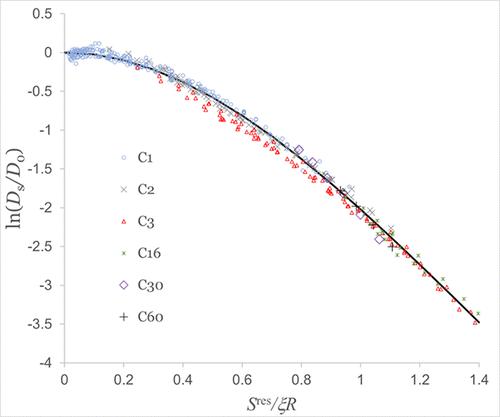当前位置:
X-MOL 学术
›
J. Chem. Eng. Data
›
论文详情
Our official English website, www.x-mol.net, welcomes your feedback! (Note: you will need to create a separate account there.)
Pure Compound Self-Diffusivity Correlation With Residual Entropy
Journal of Chemical & Engineering Data ( IF 2.6 ) Pub Date : 2024-03-19 , DOI: 10.1021/acs.jced.4c00033 J. Richard Elliott 1
Journal of Chemical & Engineering Data ( IF 2.6 ) Pub Date : 2024-03-19 , DOI: 10.1021/acs.jced.4c00033 J. Richard Elliott 1
Affiliation

|
Two models of self-diffusivity in terms residual entropy have been proposed in the literature. A generalized residual entropy model is proposed here by merging aspects of these two models. The generalized model enables inference of interaction and scaling effects by probing the significance of related terms when minimizing deviations of each model relative to experimental data. As a result, the interaction effect between residual entropy and temperature is found to be negligible using a database of 688 experimental measurements for 13 n-alkanes. Similarly, scaling analysis disfavors the “Rosenfeld” scaling. Instead, the scaling proposed by Dzugutov is favored. While implementing these two simplifications, the reduced 3-parameter model is shown to provide improved accuracy relative to the previous 6-parameter model. On the other hand, comparison to a previously proposed 2-parameter self-diffusivity model shows that the 2-parameter model provides practically the equivalent accuracy to the 3-parameter model. The 2-parameter model does not apply the principle of residual entropy. Instead, it applies a corresponding states approach, where a model is fit to the self-diffusivity of the Lennard-Jones model potential and Lennard-Jones parameters are treated as adjustable parameters. By considering accuracy relative to the number of parameters, the 2-parameter and 3-parameter models are deemed equally acceptable. The root-mean-square logarithmic deviation for the 2-parameter model is 7.5% compared to 6.9% for the 3-parameter model and 10.2% for the 6-parameter model. An open-source database of experimental measurements for 34 compounds at 1685 state points is used in all evaluations. The analysis here is limited to nonassociating compounds. The mean average percentage error was less than 5% for all three models.
中文翻译:

纯化合物自扩散率与残余熵的相关性
文献中提出了两种用残余熵表示的自扩散模型。这里通过合并这两个模型的各个方面提出了广义残差熵模型。当最小化每个模型相对于实验数据的偏差时,广义模型可以通过探索相关术语的重要性来推断相互作用和尺度效应。结果,使用包含 13 种正构烷烃 688 项实验测量的数据库,发现残余熵和温度之间的相互作用效应可以忽略不计。类似地,标度分析不利于“罗森菲尔德”标度。相反,Dzugutov 提出的缩放比例受到青睐。在实现这两种简化的同时,简化的 3 参数模型相对于之前的 6 参数模型可提供更高的精度。另一方面,与先前提出的 2 参数自扩散率模型的比较表明,2 参数模型提供的精度实际上与 3 参数模型相当。2参数模型不应用残差熵原理。相反,它应用相应的状态方法,其中模型适合 Lennard-Jones 模型势的自扩散率,并且 Lennard-Jones 参数被视为可调整参数。通过考虑相对于参数数量的精度,2 参数和 3 参数模型被认为同样可以接受。2 参数模型的均方根对数偏差为 7.5%,而 3 参数模型的均方根对数偏差为 6.9%,6 参数模型的均方根对数偏差为 10.2%。所有评估均使用包含 34 种化合物在 1685 个状态点的实验测量的开源数据库。这里的分析仅限于非缔合化合物。所有三个模型的平均百分比误差均小于 5%。
更新日期:2024-03-20
中文翻译:

纯化合物自扩散率与残余熵的相关性
文献中提出了两种用残余熵表示的自扩散模型。这里通过合并这两个模型的各个方面提出了广义残差熵模型。当最小化每个模型相对于实验数据的偏差时,广义模型可以通过探索相关术语的重要性来推断相互作用和尺度效应。结果,使用包含 13 种正构烷烃 688 项实验测量的数据库,发现残余熵和温度之间的相互作用效应可以忽略不计。类似地,标度分析不利于“罗森菲尔德”标度。相反,Dzugutov 提出的缩放比例受到青睐。在实现这两种简化的同时,简化的 3 参数模型相对于之前的 6 参数模型可提供更高的精度。另一方面,与先前提出的 2 参数自扩散率模型的比较表明,2 参数模型提供的精度实际上与 3 参数模型相当。2参数模型不应用残差熵原理。相反,它应用相应的状态方法,其中模型适合 Lennard-Jones 模型势的自扩散率,并且 Lennard-Jones 参数被视为可调整参数。通过考虑相对于参数数量的精度,2 参数和 3 参数模型被认为同样可以接受。2 参数模型的均方根对数偏差为 7.5%,而 3 参数模型的均方根对数偏差为 6.9%,6 参数模型的均方根对数偏差为 10.2%。所有评估均使用包含 34 种化合物在 1685 个状态点的实验测量的开源数据库。这里的分析仅限于非缔合化合物。所有三个模型的平均百分比误差均小于 5%。



























 京公网安备 11010802027423号
京公网安备 11010802027423号